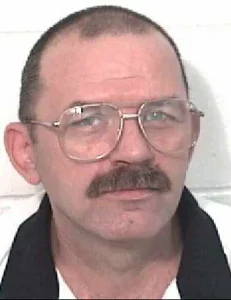William Lynd was executed by the State of Georgia for the murder of Ginger Moore
According to court documents WIlliam Lynd would get into an argument with his girlfriend Ginger Moore. He would shoot her in the face and then leave the home however Ginger would follow him and he would shoot her again and put her into the trunk of the car
While driving William Lynd would hear a noise and realize that Ginger Moore was still alive so he would shoot her yet again . Lynd would bury her body in a shallow grave and leave the State
Lynd would end up in Ohio where he would tell Leslie Joan Sharkey about what he did and ended up shooting her, before she died she would tell police about the Ginger Moore murder
William Lynd would be arrested, convicted and sentenced to death
William Lynd would be executed on May 6 2008
William Lynd Photos

William Lynd FAQ
When Was William Lynd Executed
William Lynd was executed on May 6 2008
William Lynd Case
Almost 20 years after murdering his ex-girlfriend, William Earl Lynd became the first person in the United States to die by lethal injection since an unofficial moratorium was placed on executions while the U.S. Supreme Court decided the constitutionality of the procedure.
Despite the last-ditch appeals to the state Board of Pardons and Paroles and the state and federal courts over the past few days, Lynd was executed and pronounced dead at at 7:51 p.m. Tuesday, 17 minutes after the first drug began flowing into his veins. He was the 41st man Georgia has executed since 1983, the 19th by lethal injection.
Lynd’s execution is expected to be followed soon by several in Georgia and other states. There is one scheduled in Mississippi for May 21 and in Virginia for May 27, and more planned throughout the summer in Texas, Louisiana, Virginia and Oklahoma. “It’s going to crank up again,” said lethal injection expert and Fordam Law School professor Deborah Denno. “Life is going back to the way it was” before executions nationwide were unofficially put on hold last October until the U.S. Supreme Court could rule on the constitutionality of lethal injection, the method of execution used in Georgia and 36 other states. That decision upholding lethal injection came April 16.
While Lynd’s execution was quickly scheduled, Georgia, Attorney General Thurbert Baker also asked the state Supreme Court to lift two stays issued last October. Both Jack Alderman, sentenced to die for the 1974 murder of his wife in Chatham County, and Curtis Osborne, condemned for a 1990 double murder in Spalding County, were schedule for executions that were called off last fall. Their stays have not been lifted yet. Another condemned killer, Samuel David Crowe, also could be executed soon for a 1988 murder and armed robbery in Douglas County, as the U.S. Supreme Court refused to hear his appeal just days after deciding last month lethal injection was constitutional.
With Lynd’s execution, there were no last minute court-issued stays. The 34-minute delay was so the state’s lawyers could make final checks with various courts.
As he was being executed, a dozen death penalty opponents stood in quiet protest about a mile from the sprawling Georgia Diagnostic and Classification Prison just outside of Jackson. They held signs proclaiming their opposition. “End state killing,” one sign read. Another proclaimed “not in my name.” They also stood in a circle while they prayed and sang. And just a few yards away, two women from High Falls waited in support of his execution and to show support for the victim’s family. “They waited for news of Lynd’s death at a picnic table a few yards from the death penalty protesters. “They shouldn’t let so many years go by,” said Claudia Bishop. “I feel for the victim’s family and for his family but not for him.”
Prison spokesman Paul Czachowski said Lynd spent much of his last day visiting with a sister and a girlfriend. He was “somber,” and requested a mild sedative to calm him in the hours before going to his death. Lynd’s brother and sister-in-law witnessed the execution while his mother and other relatives waited elsewhere in the prison. Lynd said only “no” when asked if he had a final statement. He also declined a prayer.
Lynd was sentenced to death in Berrien County in far South Georgia for killing his live-in girlfriend, Ginger Moore, on Dec. 22, 1988. According to testimony, Lynd and Moore got into an argument and he shot her in the face, wounding her. She followed Lynd to the front porch where he shot her a second time. Lynd put her in the trunk of a car and drove away. Trial testimony was that he killed her when he shot her a third time because she continued to thump on the trunk. But a medical examiner now says Moore was not alive when Lynd put her in the trunk, according to his appeals, and that should have made him ineligible for the death sentence because kidnapping does not apply to someone who is dead.
Lynd’s attorney, Tom Dunn, said a lack of money prevented him from presenting those findings that might have spared Lynd from a death sentence. “In my 20 years of capital defense work, except for DNA exonerations, I have never had a clearer factual basis for relieve,” Dunn said in a written statement. “No mincing of words. Just objective medical and physical evidence. Unfortunately, it came too late because of the lack of funds to hire the necessary experts.”
http://www.ajc.com/health/content/metro/stories/2008/05/05/lynd_0506.html







